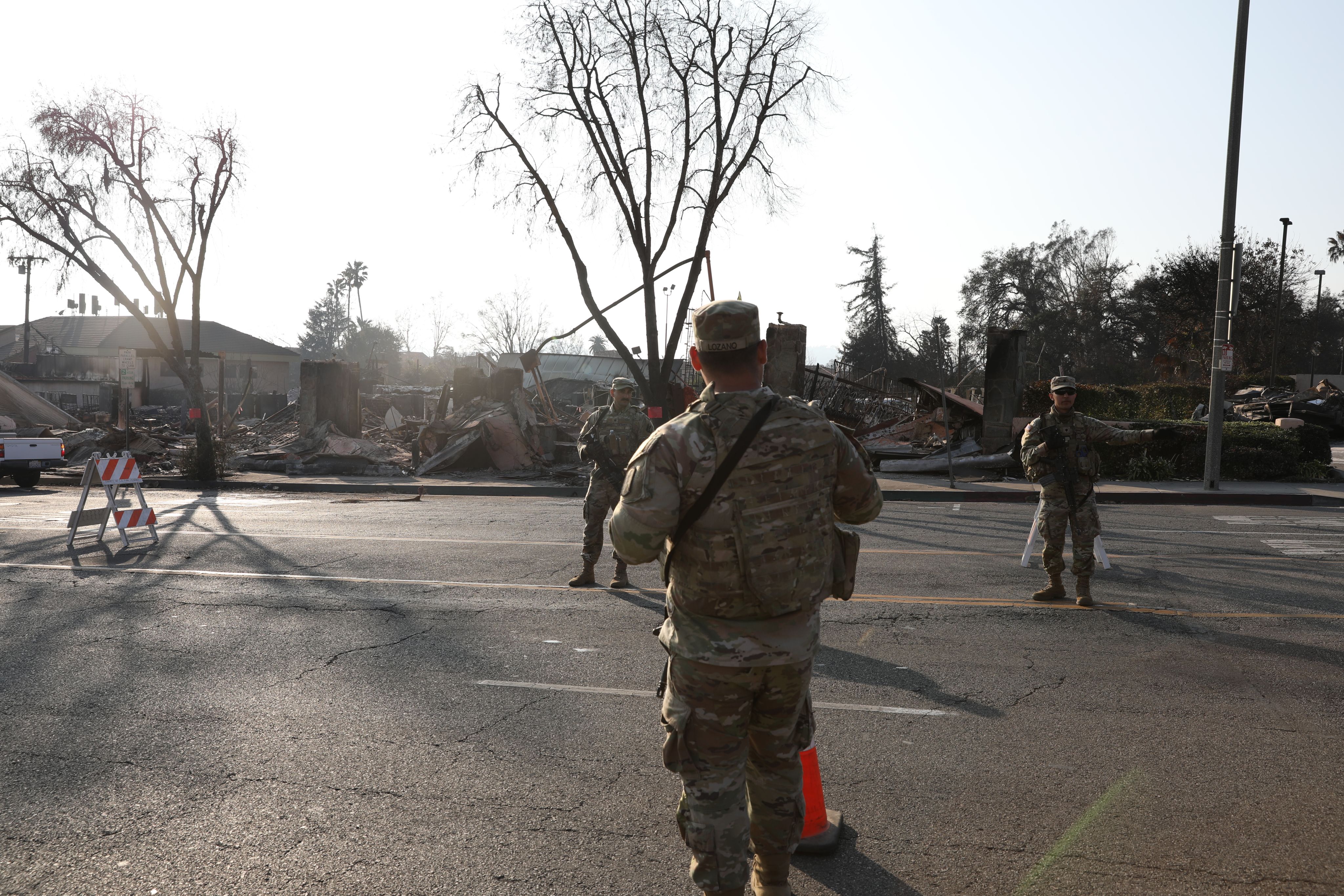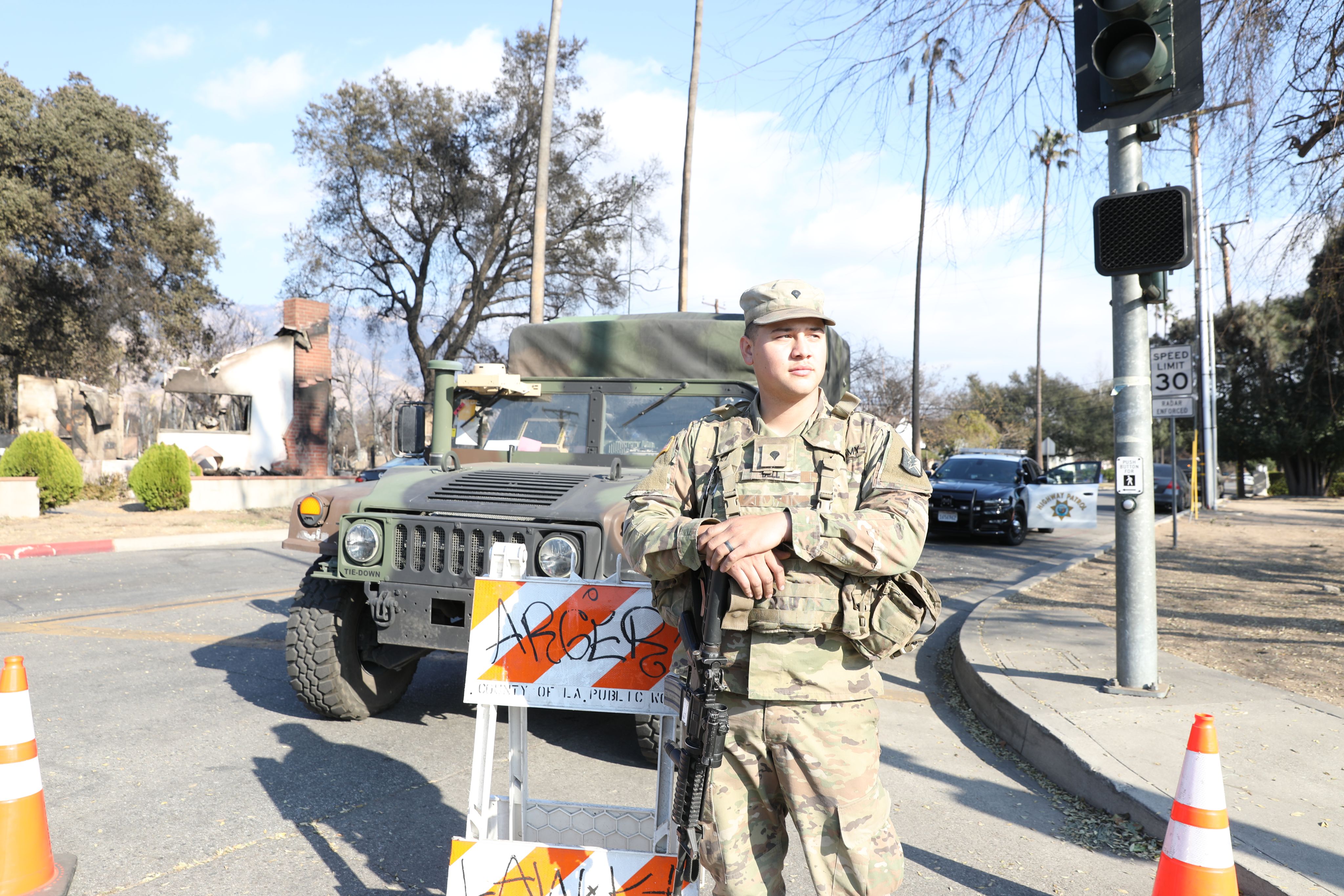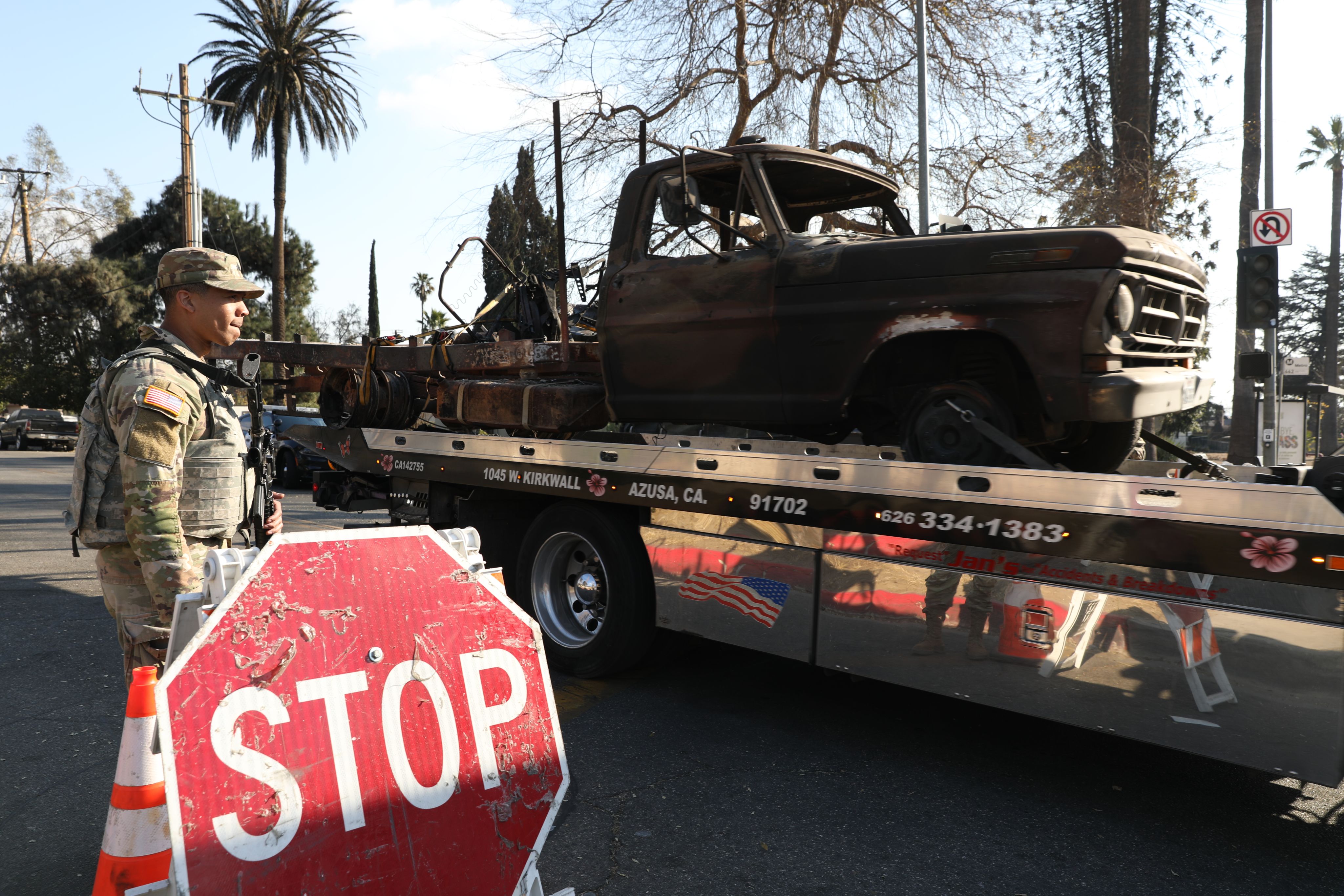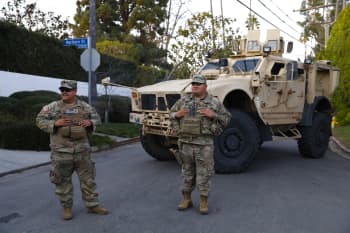From Howitzer fire to wildfire
Field artillery Soldiers support law enforcement in LA County

Story by Elizabeth Buck
69th Public Affairs Detachment
Jan. 28, 2025
LOS ANGELES – On Jan. 7, 2025, two of the most destructive wildfires in Los Angeles history sparked up in Pacific Palisades and Altadena, Calif., respectively. Within 48 hours, the California Army National Guard mobilized to support law enforcement and firefighting efforts in affected areas. At the helm of this operation was Task Force 49, called Sentinel, composed primarily of Soldiers with the Fairfield-based 49th Military Police Brigade. Under this task force were four task forces assigned to different fire-affected areas.
One such task force, called Task Force Cannon, composed mainly of field artillery Soldiers with the 1st Battalion, 143rd Field Artillery Regiment, guarded traffic control points near the Eaton Fire in Altadena, Calif. In addition to the 143rd Field Artillery Regiment, Task Force Cannon included Soldiers with the 1st Battalion, 160th Infantry Regiment, the 578th Brigade Engineer Battalion, and the 40th Brigade Support Battalion–all of which fall under the 79th Infantry Brigade Combat Team based in San Diego, Calif.
These different formations, assigned to armories across the state, and trained in everything from culinary specialist, combat medics, infantry, field artillery, heavy equipment operators, and engineers, suspended their normal military jobs to provide what LA County needed critically: safety and support.
Traffic control points allow emergency vehicles to pass through to critical areas. Military and police presence also help prevent looting. More than 100 TCPs were set up in Los Angeles County in response to the fires.
“Our job out here has been all about safety,” said U.S. Army Lt. Col. Jorge Regan, commander of 1st Battalion, 143rd Field Artillery Regiment, and commander of Task Force Cannon.
As Regan spoke, behind him stood five Soldiers with the 578th Brigade Engineer Battalion armed with rifles. They waved some cars through, then helped others turn around. As the sun began to set, their breath came out in plumes in the cold winter air. During a lull in traffic, Soldiers switched shifts, their steps slowed by fatigue. The new shift would be on for another twelve hours.
Behind the Soldiers, a building had been reduced to a pile of ash. Only brick pillars remained to mark what had once stood at this intersection on the outskirts of Altadena.
It’s not in the job description of these field artillery Soldiers to perform military police duties, but the 143rd Field Artillery Regiment was chosen to augment the personnel already on the ground.
“The field artillery unit was brought in to support these operations because of our ability to quickly establish and maintain TCPs in dynamic environments, freeing up law enforcement to focus on critical public safety tasks,” said Capt. Balreet Khaira, a field artillery officer with 1st Battalion, 143rd Field Artillery Regiment and a liaison officer for the task force.
Khaira added that working with the Los Angeles Sheriff’s Department was an example of interagency cooperation.
“By the end of our time together, deputies were using our acronyms, and we had picked up their phonetics—but more importantly, we realized that we all serve with the same values and commitment to our community, state, and country,” said Khaira.
Some TCPs were set up deep into residential neighborhoods where nothing was left but soot.
Any houses that still stood would disappear in the night, as the fire-ravaged wood blended with the black of the sky. The lingering smoke turned the air sour and stung the throats of Soldiers as they stood guard. They put on N95 masks and turned away any residents trying to check on their houses.


For a number of these Soldiers, this was not their first activation. For them, the mission epitomized their reason for joining the National Guard.
“I joined the National Guard to help people,” said Sgt. Brian Schweitzer, a cannon crewmember with 1st Battalion, 143rd Field Artillery Regiment. “That was my main goal.”
Schweitzer had previously been activated for flood response in Fresno, Calif., after the Creek Fire in 2021.
“It’s especially good for these privates [for whom] this is their first mission,” said Schweitzer. “They get the on-hand experience of what it’s like to work as a team.”
For some, the meaning of the mission extended beyond teamwork. The fires were personal for Task Force Cannon Soldiers living in L. A. County who mobilized to serve their communities.
“It’s a total California effort to come and help as much as we can,” said Regan.
One Soldier, Spc. Tyjana Grayes, a combat engineer with the 578th Brigade Engineer Battalion, grew up in Pasadena. While manning TCPs, she found out the news that her godsister and aunt’s houses burnt down. Grayes was emotional as she described going directly from drill to being activated for the fires.
“It is very sad and everything is so fresh,” said Grayes, her voice trembling, “but we’re gonna get through it together.”
Despite her sadness, she said she was glad to help and that seeing the community come together gave her hope. She held back tears as she asserted that this is why she joined the National Guard.
“This is what I signed up for,” said Grayes, “to give back to my community.”
Just as they were drawing down from the Eaton Fire, the Hughes Fire started near Castaic, Calif. Task Force Cannon was activated to man TCPs there.
“We were able to apply lessons learned from the Eaton Fire after action review, particularly feedback from Los Angeles Sheriff’s Department, which allowed us to improve our operations,” said Khaira.
The task force officially completed its mission on January 25.
The Eaton Fire is now 100% contained. It burned 14,000 acres and destroyed more than 9,000 structures. The Hughes Fire is also 100% contained after burning more than 10,000 acres. Now the California Governor's Office of Emergency Services, or Cal OES, will be overseeing the recovery effort.


Soldiers with the 79th Infantry Brigade Combat Team, California Army National Guard, receive snacks from a first responder at a traffic control point in Los Angeles County, Calif., Jan. 12, 2025. (U.S. Army National Guard photo by Sgt. William Griffen)
Soldiers with the 79th Infantry Brigade Combat Team, California Army National Guard, receive snacks from a first responder at a traffic control point in Los Angeles County, Calif., Jan. 12, 2025. (U.S. Army National Guard photo by Sgt. William Griffen)
Soldiers with the 143rd Field Artillery Regiment meet with a California Highway Patrol officer at a traffic control point near the Eaton Fire in Altadena, Calif., Jan. 16, 2025. (U.S. Army National Guard photo by Spc. Elizabeth Buck)
Soldiers with the 143rd Field Artillery Regiment meet with a California Highway Patrol officer at a traffic control point near the Eaton Fire in Altadena, Calif., Jan. 16, 2025. (U.S. Army National Guard photo by Spc. Elizabeth Buck)
March Field Fire Emergency Services from March Air Reserve Base in Moreno Valley, Calif., assisted in fire suppression efforts against the Eaton Fire in the Altadena Neighborhood of Los Angeles, Calif., on Jan. 11, 2025. Firefighters Ruben Anaya, Dakota Christensen, Brandon Dubous, Michael Goodman, and Jack Cools were assigned to Strike Team 6050A, Division N, performed overhaul duties to locate and extinguish residual fires and hot spots, preventing potential reignition and to report sensitive discoveries such as human remains or deceased pets. (US Air National Guard Photograph by Tech. Sgt. Joseph Pagan)
March Field Fire Emergency Services from March Air Reserve Base in Moreno Valley, Calif., assisted in fire suppression efforts against the Eaton Fire in the Altadena Neighborhood of Los Angeles, Calif., on Jan. 11, 2025. Firefighters Ruben Anaya, Dakota Christensen, Brandon Dubous, Michael Goodman, and Jack Cools were assigned to Strike Team 6050A, Division N, performed overhaul duties to locate and extinguish residual fires and hot spots, preventing potential reignition and to report sensitive discoveries such as human remains or deceased pets. (US Air National Guard Photograph by Tech. Sgt. Joseph Pagan)







